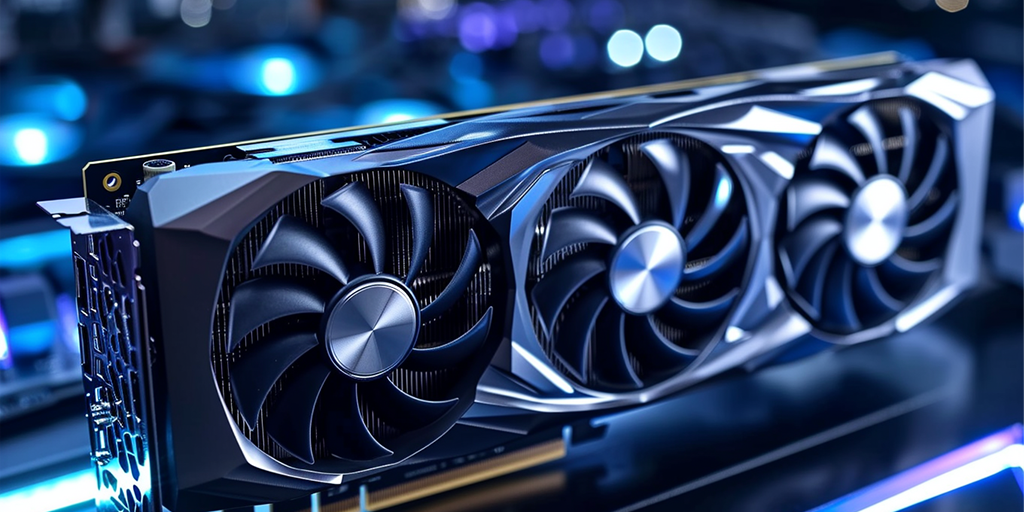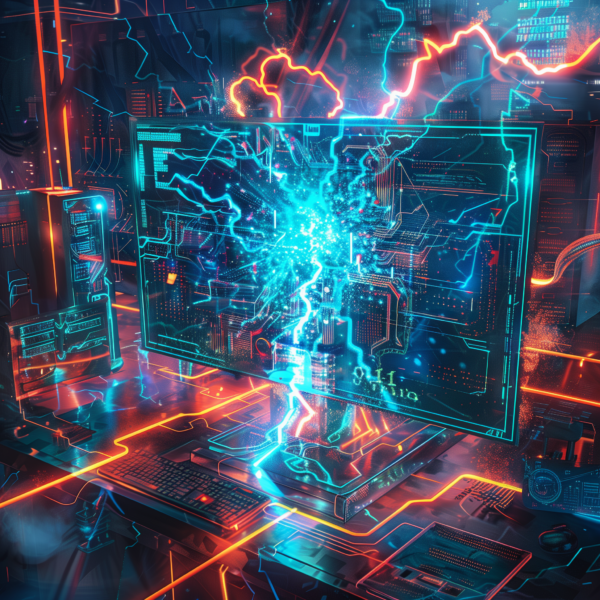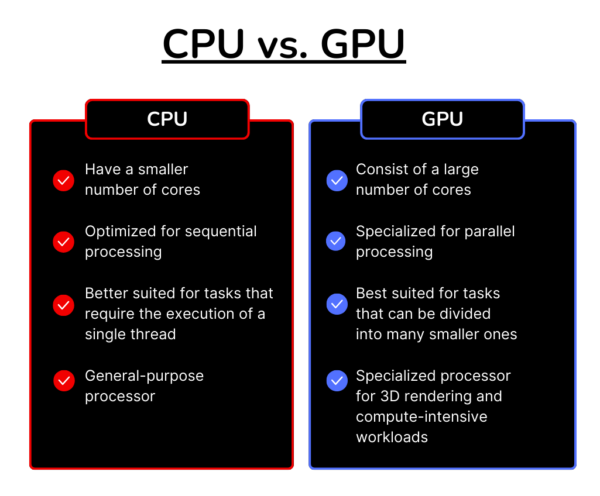
The graphics processing unit (GPU) became an integral component of almost any computer system. Initially, GPUs were engineered to speed up the rendering of 3D graphics and images.
GPUs have evolved into highly complex processors capable of handling various tasks beyond mere graphics rendering. This advancement has made them especially valuable to professionals – 3D designers, architects, and AI specialists, requiring high-performance computing for their intensive applications.
In this article, we will explain what a GPU is, its core functions and importance in modern computing.
What is a GPU (Graphic Processing Unit)
The GPU is an electronic circuit engineered to alter and adjust memory to speed up the creation of images intended for output to a display device. Unlike traditional CPU (Central Processing Unit), designed to handle a wide variety of computing tasks, GPUs are optimized for parallel tasks, making them efficient at processing simultaneously large blocks of visual data.
This specialization gives GPUs their advantage in rendering and performing quick mathematical calculations required in graphics workloads.
The structure of a GPU consists of hundreds or even thousands of cores that operate together to execute parallel processing. This configuration enables the effective management of numerous tasks simultaneously, crucial for operations such as 3D rendering, video processing, and scientific simulations.
Modern GPUs are not only present in dedicated graphics cards but also incorporated in CPUs as integrated graphics processors, providing a more economical and energy-saving option for less intensive graphics jobs. As technology has progressed, the function of the GPU has grown substantially. Today’s GPUs excel in general-purpose processing, known as GPGPU (General-Purpose Computing on Graphics Processing Units).
It has opened new possibilities for GPUs, allowing them to contribute to areas such as machine learning, where parallel processing abilities are employed to speed up complex calculations.
What does a GPU Do
The core purpose of a GPU is to produce graphics for presentation on electronic devices. Other purposes include converting data from the CPU into visual images – this task demands considerable computational strength and velocity.
The GPU assumes this role by conducting the required geometric computations for producing images and carrying out the pixel-level coloring and texturing that animate visuals on the display. This graphics production capacity is vital for applications like video games, where real-time image creation is crucial for an engaging experience.
Nevertheless, GPUs’ functions go beyond merely creating visuals. Their parallel processing power makes them perfect for expediting multiple tasks separated into smaller, simultaneous operations.
For example, GPUs can swiftly encode and decode video streams, implement filters, and conduct color grading in video editing, considerably hastening the post-production workflow. In scientific computing, GPUs can model complex phenomena by handling large datasets simultaneously, resulting in quicker and more precise outcomes.

GPUs are also becoming more popular in artificial intelligence and machine learning. Training machine learning models involves doing a lot of math called matrix multiplications. GPUs are good at this due to their parallel processing capabilities. As a result, GPUs have become a fundamental element in AI, allowing researchers and developers to train more complex models in reduced time.
In cloud services and solutions, GPUs are essential for providing processing power for cloud render nodes and GPU servers. These specialized servers utilize the power of GPUs to provide high-performance computing resources to users across the internet. Access to these cloud-based GPU resources allows 3D design and animation professionals to render intricate scenes and animations without needing costly, dedicated hardware on-site.
As the demand for better graphics and faster processing continues, GPUs are becoming more important in computing. They have become a key component in many devices, like smartphones, tablets, workstations, and servers. This drives innovation and opens up new opportunities across various sectors.
With the continuous progression in GPU technology, we are witnessing a transformation in the management of computing tasks. GPUs’ ability to process multiple tasks parallel is used to solve problems considered too complex for real-time computing. As GPUs become more powerful and more accessible through services like MaxCloudON’s cloud rendering, the opportunities for substantial improvements in areas such as virtual reality, autonomous vehicles, and personalized medicine are vast.
For professionals who rely on high-performance computing, understanding the capabilities and applications of GPUs is essential for staying at the forefront of their specific fields.
GPU vs. CPU: In-depth Comparison
When considering the core of computing devices, two key components come to mind: the CPU and the GPU. While both are essential for the operation of computers, they serve distinct functions and excel in different areas.
Design
The CPU, often referred to as the brain of the computer, is designed to handle a vast range of computing tasks and is optimized for sequential processing. It excels in tasks that require complex decision-making and support for a wide range of instructions.
On the other hand, the GPU is specialized for parallel processing, making it highly effective at managing tasks that can be divided into multiple operations and executed concurrently.
The design of a GPU is fundamentally different from that of a CPU. GPUs comprise hundreds or thousands of smaller cores that manage thousands of threads simultaneously, offering immense parallel processing capabilities.
This architecture is well-suited for graphics workloads, where you process many pixels and vertices in parallel.CPUs have fewer but more powerful cores and are better suited for tasks that require a quick execution of a single thread.

Processing Power
Regarding processing power, GPUs provide a significant advantage for simultaneous tasks. Modern GPUs, such as those made by Nvidia, are extremely powerful computationally. They’re essential for managing tasks with large amounts of data and requiring fast speeds like graphics rendering, where GPUs can render images rapidly and effectively.
Typically, graphics cards are plugged into a computer’s motherboard chipsets and function as an output source for displaying visuals on a monitor.
They come in two primary varieties:
- Integrated graphics: Integrated graphics cards are built into the same chip as the CPU and share memory with the processor, making them less powerful but more energy-efficient.
- Dedicated (discrete GPU) graphics cards: Discrete graphics cards are separate pieces of hardware with their dedicated memory. They are usually more powerful, offering better graphics performance for demanding tasks, for example, gaming or professional 3D rendering.
Considering task suitability, the choice between a CPU and a GPU depends on the nature of the computing task. Most CPUs can handle various tasks, including running the operating system, executing applications, and performing general-purpose computations.
However, GPUs are preferred for tasks like video editing, 3D rendering, or scientific simulations that require complex computer graphics or parallel processing due to their superior graphics performance and parallel processing abilities.
By selecting the appropriate processing unit for the task, these experts can improve their workflows and achieve superior outcomes in shorter periods.
What is the Difference Between a GPU and a Graphics Card
GPUs and graphics cards are interchangeable, although they represent different parts of a computer’s hardware. The GPU is the electronic circuit responsible for creating images and performing parallel computations. It is the crucial component that decides the graphics performance of the system.
The graphic card is a piece of hardware that includes the GPU and additional components such as memory (VRAM), cooling systems, and connections to the motherboard. Graphics cards are typically inserted into a computer’s motherboard and operate as an output source for displaying visuals on a monitor.
Types of GPUs
GPUs arrive in diverse configurations, each crafted to meet particular needs and performance benchmarks. The two main categories of GPUs are integrated and discrete (dedicated).
Let’s see them in more detail below:
- Integrated GPUs: Integrated GPU is engineered into the same chip as the CPU, are perfect for everyday computing tasks, such as web browsing, office applications, and simple photo editing. They are also more economical and energy-saving, as they do not need extra hardware and use the system’s existing memory.
- Discrete GPUs: They are independent units with their dedicated memory, known as VRAM (Video RAM). These GPUs are stronger than integrated ones and can handle demanding graphics tasks. Discrete GPUs are essential for professionals in fields such as 3D design, video editing, and gaming, where high-resolution textures, intricate models, and real-time rendering are the standards.
Numerous models and brands exist within the domain of discrete GPUs, each offering a different level of performance. Nvidia GPUs, for example, are known for their high-performance computing capabilities and are widely used in gaming, design, and rendering. Intel discrete GPUs are another option, providing competitive graphics performance for many computing tasks.
Integrated vs. Discrete GPUs
The choice between integrated and discrete GPUs ultimately depends on the user’s specific needs and the computing tasks they intend to perform. For those who demand better graphics performance, such as animation studios or machine learning experts, discrete GPUs with parallel processing power and dedicated VRAM are the obvious choice.
Nevertheless, for users with more modest graphics needs, integrated GPUs provide a harmonious solution that can manage basic graphics workloads without extra expense and power usage of a dedicated graphics card.
Grasping the various kinds of GPUs and their distinct advantages is crucial for making knowledgeable choices when picking hardware for computing tasks. Whether for gaming, design, rendering, or business applications, the appropriate GPU can affect the user’s experience and efficiency. With technological progress, GPUs will drive innovation and enable new opportunities across various sectors and applications.
GPU Usage Examples
GPUs have become essential in various industries, revolutionizing how we approach complex computing tasks. Their ability to handle parallel operations makes them ideal for a wide range of applications, from enhancing graphics processing in gaming to accelerating computations in high-performance computing environments.
Cloud Servers
In server environments, GPUs are increasingly used to enhance performance for data-heavy tasks. Cloud render providers, for example, use GPU servers to provide scalable resources for 3D rendering, enabling users to finish renderings quicker than conventional CPU-based servers could handle.
This GPU computing power is utilized also in business applications, where speed and efficiency are crucial.
Gaming Industry
GPUs have always excelled in gaming, providing the necessary processing power to create immersive video game graphics.
Modern GPUs, with their sophisticated features like ray tracing, lift the visual quality of games to new levels, creating realistic lighting and shadows that significantly improve the gaming experience.
3D Design and Rendering
Design and rendering are other areas where GPUs are indispensable. Architects and 3D artists rely on powerful GPU acceleration to perform architectural rendering in real-time, enabling them to visualize their creations very detailed and accurately.
This capability is crucial for making design adjustments on the fly and ensuring that the final product meets the desired specifications.

Crypto Mining
Crypto mining is another field that has leveraged GPUs’ parallel processing capabilities. Crypto miners use dedicated GPUs to solve complex cryptographic puzzles, an integral process of verifying transactions and securing blockchain networks.
GPUs’ efficiency in performing these parallel operations has made them a popular choice among crypto miners.
Machine Learning and AI
Lastly, GPUs have a significant impact on machine learning and AI. Their parallel processing capabilities are essential for training deep learning models using servers for machine learning, which require handling vast amounts of data and performing complex calculations at high speeds.
Nvidia GPUs, in particular, have been at the forefront of this revolution, providing the necessary hardware to drive advancements in AI research and applications.
Conclusion: The Importance of GPUs in Modern Computing
GPUs have transformed the landscape of modern computing, offering unparalleled processing power and efficiency for various tasks. Their importance extends across multiple industries, from gaming and entertainment to scientific research and artificial intelligence.
As we explore the limits of technology, GPUs will continue to lead the way, driving innovation and enabling professionals to achieve more in less time. For those in 3D design, animation, and machine learning, GPUs are not just a luxury but a necessity.
The opportunity to use GPU servers through cloud services has made high-performance computing more accessible to a broader range of users. It allows for more flexible and scalable workflows. As GPUs continue to evolve, we can expect them to play an even more significant role in shaping the future of technology and computing.
Sources:
- NVIDIA: GPU Technology
- Intel: What is a GPU?
- AMD: Radeon Raytracing
- ScienceDirect: Graphics Processing Unit
- TechRadar: What’s the difference between a GPU and a graphics card?
Frequently Asked Questions:
-
What is the primary purpose of a GPU?
The main objective of a GPU is to accelerate the rendering of computer graphics and video processing, enabling smooth and efficient display of images and animations on screen. They are also increasingly used for general-purpose computing tasks that can benefit from their parallel processing power.
-
Which is better: CPU or GPU?
The answer depends on the specific computing tasks. CPUs are better suited for general-purpose tasks and single-threaded operations. At the same time, GPUs excel in tasks that can be parallelized, such as graphics rendering and machine learning.
-
Are GPUs good for video editing?
Yes, GPUs are excellent for video editing as they can quickly process video data, apply effects, and render high-resolution footage, making the editing process faster and more efficient.
